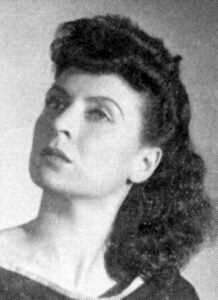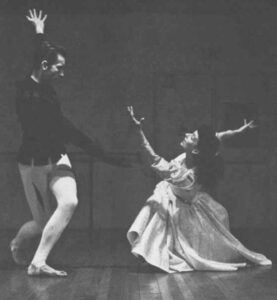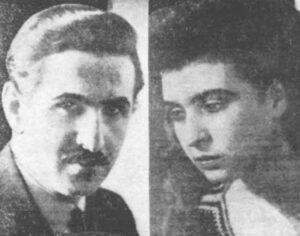sAIDA GERRARD
1913-2005
A PAGE IN HISTORY
BIOGRAPHY
Born: April 9, 1913, Toronto
Died: March 15, 2005, Los Angeles
Born into a family of amateur musicians, Saida Gerrard grew up studying dance and music. Beginning at the Peretz School in Toronto, her dance teachers included Maude McCann, Nora Griffiths and Amy Sternberg. She also studied Dalcroze Eurhythmics with Madeleine Boss Lasserre at the Toronto Conservatory of Music. In the 1930s, Gerrard travelled to New York City and, under scholarship, trained with Hanya Holm at the newly opened Mary Wigman School. In New York she also studied with Martha Graham, Margaret Craske and Fe Alf as well as Hebraic dance with Benjamin Zemach and composition with Louis Horst. She returned to Toronto frequently to perform and teach and was featured in the Promenade Symphony Concerts many times. Thousands turned up at Varsity Arena for her staging of The Sorcerer’s Apprentice (1934). Other important works include Death and Transfiguration (1935) with lighting by Herman Voaden; Dance Suite – Songs of Unrest (1935); Hunger (1935) set to percussion accompaniment; Negro Spirituals (1935); Sea Shanties (c. 1937) set to music composed by her husband, Aube Tzerko; Hostages, 1942 (1942); and Die Naye Hagodah (Glory of the Warsaw Ghetto) (1949) choreographed to Max Helfman’s choral tone poem. Die Naye Hagodah debuted in Toronto using dancers from the New Dance Theatre but it was also later set in Detroit and Chicago. The Machine (1938) was an ice ballet Gerrard produced for the Toronto Skating Club. As a performer, Gerrard danced with Charles Weidman’s company and her own New York Children’s Theatre, among others. She settled in Los Angeles in 1951 after collaborating there with composer Max Helfman. She worked with the Guild Opera Company, taught at Eugene Loring’s School of American Dance, staged work for the Idyllwild Arts Foundation and in 1960 began teaching at the University of Judaism. Her work at the university lent stability to her company of dancers and enabled her to present this group in university performances. In the mid-1980s, Gerrard formed the Heritage Dance Company, which focussed on works related to her Jewish heritage.
CONTENTS
- photocopies of magazine and newspaper clippings, playbills (copies and originals), brochures (copies and originals), correspondence, small selection of photos (copies and originals)
NOTABLE
- photocopies from The Curtain Call (March 1935, May 1935, November 1936) with images and news regarding Alison Sutcliffe, Boris Volkoff and Saida Gerrard
- photocopies of several newspaper reviews describing Gerrard’s choreography for Dukas’ Sorcerer’s Apprentice
- original brochure for the Saida Gerrard Studio of Modern Dance, Toronto, c. 1935
- photocopies of class notes handwritten by Madelaine Boss Lasserre (accompanied by typed notes contributed by historian Selma Odom), a Dalcroze Eurhythmics teacher who attended Gerrard’s modern dance classes
- photocopy of magazine article: Saida Gerrard, “The Dance”, The Jewish Standard, April 19, 1935
- photocopies of several newspaper reviews describing Gerrard’s choreography for Max Helfman’s Die Naye Hagodah (Glory of the Warsaw Ghetto) for a production involving the Toronto Jewish Folk Choir, the Toronto Symphony Orchestra and the Neo Dance Theatre
- original silver jubilee season (1949/50) brochure for the Toronto Jewish Folk Choir, Saida Gerrard listed as a guest artist to present choreography for Max Helfman’s Die Naye Hagode and Earl Robinson’s The Lonesome Train
- photocopies of several newspaper preview articles and reviews for Saida Gerrard’s choreography for Earl Robinson’s The Lonesome Train for a production by the Toronto Jewish Folk Choir, New Dance Theatre (formerly Neo Dance Theatre), Canadian Little Symphony and Negro Choral Society; also photocopy of playbill for this performance
- original issue of Bravo magazine/playbill which includes an article chronicling the history of claqueurs: George Martin, “Noisy Phantom of The Opera”, Bravo, Vol. 1, No. 2, 1961
- correspondence to Dance Collection Danse from the 1990s
- preliminary notes, possibly for a grant application or programme notes, for the choreographic work A Legend of Queen Sabbath (c. 1985)o
CROSS REFERENCES
PORTFOLIOS
- Cynthia Barrett, Nancy Lima Dent (See Gerrard Portfolio for information on Madeleine Boss Lasserre and Herman Voaden)
ORAL HISTORY
- Saida Gerrard (8 hours, interviews conducted by Lawrence Adams.
BOOKS
- Landen Odom, Selma. 2002. “Music and Movement Connections: The Overlapping Careers of Madeleine Boss Lasserre and Saida Gerrard.” In Iro Valaskakis Tembeck, ed., Estivale 2000: Canadian Dancing Bodies Then and Now. Toronto: Dance Collection Danse Press/es. ISBN: 0-929003-50-0
- Landen Odom, Selma. 2000. In Susan Macpherson, ed. Encyclopedia of Theatre Dance in Canada/Encyclopédie de la Danse Théâtrale au Canada. Toronto: Dance Collection Danse Press/es. ISBN: 0-929003-42-X
WORKS
- The Sorcerer’s Apprentice (1934), Paul Dukas
- Country Dance (1934), Bela Bartok
- Death and Transfiguration (1935), Richard Strauss
- Dance Suite – Songs of Unrest (1935), (My love dwelt in a northern land, Edward Elgar; The Mermaid, Robert Schumann; You stole my love, [George Alexander or Walter] Macfarren; The Hawthorne Tree, arr. by Gerrard Williams; King Ladislaus’ Men (based on Hungarian traditional fragments), Zoltan Kodaly)
- Hunger (1935), percussion accompaniment
- “Polka” from Schwanda (1935), Jaromír Weinberger
- Negro Spirituals (1935), unknown
- Sea Shanties (c. 1937), Aube Tzerko
- Waterfront Hornpipe (c. 1937), Aube Tzerko
- The Machine (an ice ballet for the Toronto Skating Club) (1938), Wallingford Riegger
- Fancy Fanny’s Judgement Day (1939), Wallingford Riegger and Genevieve Pitot
- The Grapes of Wrath (c. 1941), unknown
- Hostages, 1942 (1942), unknown
- Die Naye Hagodah (Glory of the Warsaw Ghetto) (1949), Max Helfman
- The Lonesome Train (1950), Earl Robinson
- Hebraic Legend (1950), Maurice Ravel (arranged by Aube Tzerko)
- Vig-Lid (Cradle Song) (1950), Traditional (arranged by Aube Tzerko)
- Tapestry (1956), Traditional 16th-century music
- Visions and Prophecies (1956), Ernest Bloch
- The Unanswered Question (1961), Charles Ives
- Ballads of Our Land (1961), Ballads sung by Odetta
- Ancestral Memories (c. 1985), Aaron Copeland
- A Legend of Queen Sabbath (c. 1985), Traditional folk songs and music composed by Cantor William Sharlin
PERSONNEL
Miriam Adams, C.M.
Co-founder/Advisor
Amy Bowring
Executive and Curatorial Director
Jay Rankin
Administrative Director
Vickie Fagan
Director of Development and Producer/Hall of Fame
Elisabeth Kelly
Archives and Programming Coordinator
Michael Ripley
Marketing & Sales Coordinator
CONTACT
1303 – 2 Carlton St.
Toronto, ON
M5B 1J3
Canada
Phone: 416-365-3233
Fax: 416-365-3169
info [AT] dcd.ca
HOURS
Mon. – Fri. 10 a.m. – 5 p.m.
Appointment Required
Contact our team by email or call one of the numbers above













